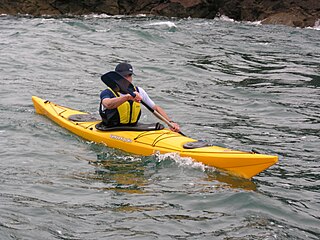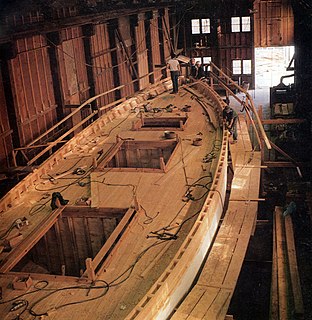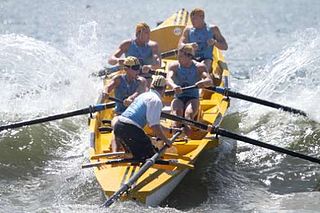External links
| | This article about a specific civilian ship or boat is a stub. You can help Wikipedia by expanding it. |
The Sea Bright Skiff is a box-skegged skiff developed on the northern shore of New Jersey. It was used for fishing, by being launched through the surf, sailed to the fishing grounds, and returned through the surf.
The boat is quite different from the Jersey Skiff, being more round-sided, with less freeboard, and the distinct "box skeg" that proved particularly useful when engines were adopted. The boat has a nearly straight stem, rounded sides, a narrow flat bottom that becomes the bottom of the skeg, and a heart shaped transom. The boat was usually rigged with a spritsail mainsail and small jib with an unstayed mast. The early fishing versions used an oar as the rudder, more modern versions, however, have a regular rudder & tiller.
The larger pound boat, built to the same lines, was generally around 30 feet, but could run to 50 feet in length, 10 foot beam. It was used to carry to shore fish caught in offshore weirs. Like sardine carriers and oyster buy-boats, it was heavily laden on return, with very little freeboard.
This boat has nearly disappeared from the shores of New Jersey except as used by lifeguards (rowing configuration only).
A short video on the skiff can be found here.

A kayak is a small, narrow watercraft which is typically propelled by means of a double-bladed paddle. The word kayak originates from the Greenlandic word qajaq.

A dory is a small, shallow-draft boat, about 5 to 7 metres or 16 to 23 feet long. It is usually a lightweight boat with high sides, a flat bottom and sharp bows. It is easy to build because of its simple lines. For centuries, the dory has been used as a traditional fishing boat, both in coastal waters and in the open sea.

A dinghy is a type of small boat, often carried or towed by a larger vessel for use as a tender. Utility dinghies are usually rowboats or have an outboard motor. Some are rigged for sailing but they differ from sailing dinghies, which are designed first and foremost for sailing. A dinghy's main use is for transfers from larger boats, especially when the larger boat cannot dock at a suitably-sized port or marina.
A skeg is a sternward extension of the keel of boats and ships which have a rudder mounted on the centre line. The term also applies to the lowest point on an outboard motor or the outdrive of an inboard/outboard. In more recent years, the name has been used for a fin on a surfboard which improves directional stability and to a movable fin on a kayak which adjusts the boat's centre of lateral resistance. The term is also often used for the fin on water skis in the U.S. It has been used for the vertical fin on seaplane hulls and floats. The wear-bar on the bottom of snowmobile ski may also be called a skeg.

A scow is a type of flat-bottomed barge. Some scows are rigged as sailing scows. In the 19th and early 20th centuries, scows carried cargo in coastal waters and inland waterways, having an advantage for navigating shallow water or small harbours. Scows were in common use in the American Great Lakes and other parts of the U.S., in southern England, and in New Zealand. In Canada, scows have traditionally been used to transport cattle to the islands of New Brunswick's Saint John River. In modern times their main purpose is for recreation and racing.

A sea kayak or touring kayak is a kayak developed for the sport of paddling on open waters of lakes, bays, and the ocean. Sea kayaks are seaworthy small boats with a covered deck and the ability to incorporate a spray deck. They trade off the manoeuvrability of whitewater kayaks for higher cruising speed, cargo capacity, ease of straight-line paddling, and comfort for long journeys.

Boat building is the design and construction of boats and their systems. This includes at a minimum a hull, with propulsion, mechanical, navigation, safety and other systems as a craft requires.
The Swampscott dory is a traditional fishing boat, used during the middle of the 19th century by fishing villages along the North Shore coast of Massachusetts centered on Swampscott. It is designed to be launched off the beach. The rounded hull provides more buoyancy for launching through surf than the slab sided banks dory. The flat bottom allows the boat to sit upright on the beach. The lack of a keel keeps the boat from being grabbed by a wave and allows the boat to pass cleanly through the surf. The boat still heels easily which allows large fish to be rolled into the boat vs having to lift the fish completely up over the gunnel. The Swampscott Dory, a fishing boat still in use throughout the world today, was invented in 1840 by Theophilius Brackett to row and to pull lobster pots. These dories compare favorably with the New Bedford whaleboat and the Gloucester seine boat.

The Gloucester dory is a variant of the Banks dory, a type of narrow-bottomed, slab-sided boat, common in the North Eastern United States. It is characteristically smaller and lighter, with less overhang, both bow and stern, and less freeboard. It retains the Banks dory's slab sides. Gloucester dories were designed to be launched through the surf behind a breakwater for daily fishing and lobstering off the Massachusetts shore.
The Jersey Skiff is a beach launched boat first appearing around the end of the 19th century. They were first used as fishing boats, to be launched through the surf, sailed to the fishing grounds and then retrieved through the surf.

A dive boat is a boat that recreational divers or professional scuba divers use to reach a dive site which they could not conveniently reach by swimming from the shore. Dive boats may be propelled by wind or muscle power, but are usually powered by internal combustion engines. Some features, like convenient access from the water, are common to all dive boats, while others depend on the specific application or region where they are used. The vessel may be extensively modified to make it fit for purpose, or may be used without much adaptation if it is already usable.

A surfboat is an oar-driven boat designed to enter the ocean from the beach in heavy surf or severe waves. It is often used in lifesaving or rescue missions where the most expedient access to victims is directly from the beach.

Seine fishing is a method of fishing that employs a surrounding net, called a seine, that hangs vertically in the water with its bottom edge held down by weights and its top edge buoyed by floats. Seine nets can be deployed from the shore as a beach seine, or from a boat.
A skiff is any of a variety of essentially unrelated styles of small boats. Traditionally, these are coastal craft or river craft used for leisure, as a utility craft, and for fishing, and have a one-person or small crew. Sailing skiffs have developed into high performance competitive classes. Many of today's skiff classes are based in Australia and New Zealand in the form of 12 ft (3.66 m), 13 ft (3.96 m), 16 ft (4.88 m) and 18 ft (5.49 m) skiffs. The 29er, 49er, SKUD and Musto Skiff are all considered to have developed from the skiff concept, all of which are sailed internationally.

Sharpies are a type of hard chined sailboat with a flat bottom, extremely shallow draft, centreboards and straight, flaring sides. They are believed to have originated in the New Haven, Connecticut region of Long Island Sound, United States. They were traditional fishing boats used for oystering, and later appeared in other areas. With centerboards and shallow balanced rudders they are well suited to sailing in shallow tidal waters.

Coastal and offshore rowing is a type of rowing performed at sea. Due to the harsher conditions encountered, the boats are wider and more robust than those used on rivers and lakes. In North America, this sport is often called open water rowing.

The word Drascombe is a trademark that was first registered by John Watkinson who applied it to a series of sailing boats which he designed and built in the period 1965–79 and sold in the United Kingdom (UK). They comprised the Coaster, Cruiser Longboat, Dabber, Drifter, Driver, Gig, Launch, Longboat, Lugger, Peterboat, Scaffie, Scaith and Skiff, together with a few other one-offs. They have wide and deep cockpits, adaptable boomless rigs and high bulwarks.

A sneakbox is a small boat that can be sailed, rowed, poled or sculled. It is predominantly associated with the Barnegat Bay in New Jersey, just as the canoe-like Delaware Ducker is associated with the New Jersey marshes along the Delaware River near Philadelphia.

The Fox was a specially built surfboat to be rowed across the Atlantic Ocean.
Masula boat, also known as masulah boat, is a kind of non-rigid boat built without knees used on the coast of Madras, India, along with catamarans.